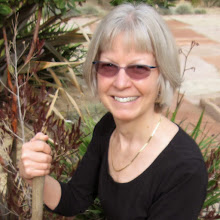In less than two weeks, it will be 35 years since escrow closed and I embarked on garden and home ownership.

My "inherited" garden consisted of a small patch of lawn out front, surrounded by "freeway daises" near the front porch and juniper tams toward the street; bermuda grass lawn in back almost to the fence; several large rose bushes; reseeding annuals, such as johnny-jump-ups and California poppies; tulips planted in a "cold spot" that pushed through heavy soil to rebloom each year; a cluster of bearded iris*; three ubiquitous clumps of bird-of-paradise; three multi-trunked flowering pomegranates stuffed into one corner, underplanted with white belladonna or "naked lady" lilies; one for-the-birds-fruit-bearing tiny 'Nana' pomegranate*; a small flowering plum; one gumdrop-shaped privet; and hedge-trimmed algerian ivy in the narrow parking strip. Other than two towering street trees, the only real tree was a rather large crape myrtle* near one corner of the garage, underplanted with creeping vinca.
*All that remains of the original garden, bearded iris having been dug up, divided, moved and replanted numerous times.
In the first several years, I was in a career that found me working long hours, commuting 27 miles, van-pooling when schedules allowed, then transferring out-of-state. Consequently, other than weekend raking, sweeping, weeding, watering with various hose-end contraptions, and pushing either a me-powered or later an electric-powered lawnmower around, my "garden" received little attention. However, I do recall those activities taking me on average about 7 precious daylight hours per week to accomplish. A few big jobs were saved for my dear father, such as removing the pathetic "gum-drop tree" that quickly became even more unsightly because I refused even to trim it. I never did play a round of croquet, which is what I had thought you were supposed to do with a lawn.
While I lived out-of-state, my sister, Faith and her family moved into my home and garden. The four of them made much better use of it, especially the backyard.
For a few years when her twin girls were small, Faith did not work outside the home. Her husband, Tom, however did take on a second job during that time. On weekends, Tom built or assembled play equipment. A cabinet-maker by trade, he was quite handy. Faith put in a small vegetable garden, did the weekly gardening chores, and mulched around the rose beds. Between the two of them, they turned my pitiful "yard" into a perfect playland for preschoolers. At least that is the way it looked when I would come home a couple of times a year to visit. And especially at their garden party when my nieces, Kari and Sarah, turned 3!
Far right above, is the result of my later having hired a gardener to install new sod and an irrigation system -- greener lawn, but run-off onto patio and not sustainable, especially in drought years. Still, I must admit to having been taken in by the lure of green envy.
As the years -- both drought and wet ones -- came and went, I became interested in growing food. Initially, fruit trees -- thinking, why not gain at least three benefits from planting a tree? Food, privacy, and shade in one package. The first we planted was a grapefruit tree, which my father had started from seed about 12 years prior. It is the only citrus I believe that will produce good fruit without being grafted. Of course, because I also wanted shade and privacy, much of the fruit is now out of reach for easy picking. One of many lessons learned the hard way. Still, to me the rewards outweigh.
While my father was alive, I had a ready "market" for the grapefruit. Also, help with picking! And, I swapped grapefruit with my neighbor's brother who lived a couple of miles away, for fresh figs from his five trees.
Lately, I have chosen to give the fruit I cannot use to a couple of local food pantries. They are always happy to receive fresh produce.
Through the 1990s, still not having a lot of time to devote to gardening but wanting to learn more about it, I planted small beds of flowers around the lawn. Roses were popular. Eventually, there were way too many of them!
And, there were gerbera daisies…
And day lilies, too!
One rose I plan to always keep, because it came from my grandmother's garden...
I loaded up a little raised planter with daffodil bulbs. (In the background -- a dwarf valencia orange.)
Then, when blooms were spent and waning leaves became an unsightly mess, I did to them what I did to my hair when it was unruly. I braided them!
One day in the early years, I had the not-so-bright idea to plant a couple of what turned out to be Monterey pine trees. My dear daddy had obliged me with the two cute, fluffy little saplings, and helped me plant them, too! One, right under the power lines in back met its demise shortly after the Department of Water and Power whacked the top off. The other finally dwarfed my house and had been planted so the trunk eventually grew to less than two feet from my roof. Branches extended dangerously close to my neighbor's chimney.
Above photo (taken the day before tree removal): Rick Ranney.
That sums up the first two decades in my garden. Stay tuned for what has evolved since the turn of this century!
Above "teaser" photo: Barbara Eisenstein,
weedingwildsuburbia.com. All other photos (unless noted): Janis Hatlestad, Better Earth Garden Design,
begarden.com.









































